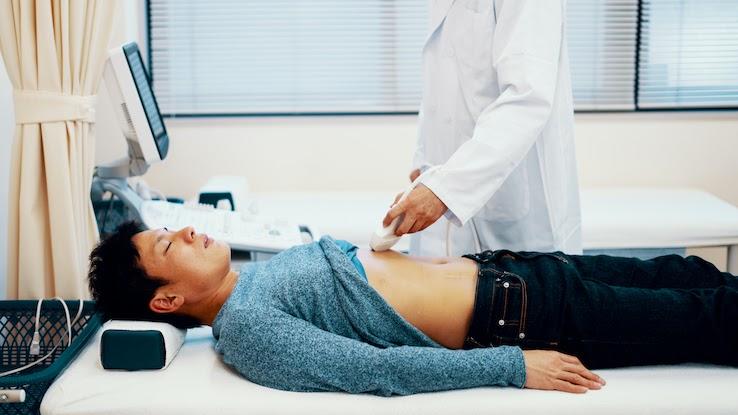How to Tell if Baby Has Umbilical Hernia

A hernia is a medical status that occurs when a weakened portion of muscle wall or membrane allows internal organs and/or surrounding fatty tissue to protrude outside of the space where they normally sit in your body. There are several unlike types of hernias, and they're classified based on the expanse of your body where they develop. Hernias are most commonly found around the abdomen and lower torso regions.
Regardless of the location, hernias can range in severity; some hernias resolve on their ain and some require surgical intervention to prevent dangerous consequences. Read on to detect out how hernias can be prevented, identified and managed.
Hernia Symptoms and Warning Signs

There are several dissimilar types of hernias. Out of those listed below, nearly 80% of hernias people feel are inguinal or femoral.
- Inguinal: Occurs in the groin area where the skin of the thigh and the body joins (likewise known every bit the inguinal fold)
- Femoral: Occurs at the top of the thigh below the inguinal ligament
- Umbilical: Occurs when increased abdominal force per unit area leads to a hernia in the belly surrounding the umbilicus
- Incisional: Occurs afterwards abdominal or pelvic surgery when the weakened tissues around the surgery site may serve every bit the site for incisional hernias
- Diaphragmatic/Hiatal: Occurs when in that location's a defect in the diaphragm (a muscle that separates the abdomen and the lung cavity) and role of the stomach or intestines may protrude up into the breast crenel, causing internal bulges
Hernias tin can occur of a sudden and without alarm or develop more slowly over fourth dimension. Depending on the hernia's anatomical location too as its cause, symptoms can range from nonexistent to severe. Mild hernias sometimes won't cause any symptoms due to the pocket-sized size of the protrusion. If you do experience symptoms, they may include:
- Bulging of your skin that you can see, experience or even push back into your body
- A sensation of force per unit area, especially when you tense the muscles surrounding the hernia
- Pain or a burning sensation that may increment during straining activity like coughing or a bowel movement
- Acid reflux or heartburn, which appears with diaphragmatic hernias
In some cases, intestinal tissue tin become trapped within the herniated surface area. This tin lead to two serious medical complications that result in the following symptoms:
- Obstruction (blockage of the intestinal tract): Severe pain, nausea, vomiting, stomach pain
- Strangulation (loss of blood supply): Increased pain, bruise-like discoloration of the hernia, increased heart rate, fever — strangulation is a medical emergency and can lead to significant tissue death if not treated right away
If you're experiencing any of the above symptoms, they're indications you've adult a hernia. If bulges under your skin increment in size when yous're coughing or straining — or if you have recurring discomfort or pain at the same generalized location when lifting heavy objects or during strained bowel movements or urination — this may be a warning sign. Visit your physician as soon as possible to accept them confirm the presence of a hernia or provide some other diagnosis.
Causes of and Risk Factors for Hernias

Hernias can happen to almost anyone at whatever fourth dimension, although the bulk of hernias occur in adults. Some individuals may be more than at risk than others. Mostly, the presence of a hernia is related to increased internal trunk pressure and/or weakened muscle or connective tissue. The following factors can contribute to the onset of a hernia:
- Repeated strain: A chronic cough or constipation can increase internal pressure and worsen a hernia.
- Heavy lifting: Workplace or recreational heavy lifting can strain your torso and lead to the evolution or worsening of a hernia.
- Injury: Muscle strains or joint dislocations can make you more vulnerable to developing hernia protrusions.
- Age: Connective tissue typically becomes weaker in older adults over fourth dimension.
- Assigned sex: Hernias occur more commonly in people who are assigned male person at nativity.
- Pregnancy: Increased internal organ pressure can trigger a hernia.
- Surgery: Surgical incisions and scarring tin pb to weakened tissue areas where hernias tin can more easily occur.
- Connective tissue disorders: These conditions may exist present since nativity and atomic number 82 to hernias.
- Premature nascency or fetal development: Failed embryonic closures in male person fetuses can set the stage for inguinal hernias to grade afterward in adult life.
- Family history: Having shut relatives with a history of hernias increases your likelihood of developing this condition.
- Previous hernia: Having already had a hernia makes it more than likely that some other volition occur.
If you have multiple adventure factors or doubtable that you lot're experiencing symptoms of a hernia, it's important to contact your healthcare provider for assessment and treatment options.
Hernia Testing and Diagnosis

Because hernias are external or internal protrusions of body parts due to a combination of weakened muscle tissue and increased internal body pressure level, the two well-nigh common methods for testing and diagnosing hernias are concrete exams and X-ray imaging. Depending on the area where the hernia is nowadays, your healthcare provider may perform additional diagnostic testing to rule out other more serious medical conditions that are unrelated to hernias.
- Physical exam: A healthcare provider commonly palpates, or feels, the affected bulge to gauge the texture, size and fullness of the protrusion and run into its reaction to pressure level. They'll also visually evaluate the protrusion for discoloration; inflammation or abnormally dark blotches may signify infection or strangulation.
- Medical history: Your healthcare provider may ask nigh previous surgeries, a family unit history of hernias, recent activity levels or injuries and recent symptoms yous've experienced.
- Imaging: Your provider may order an 10-ray, ultrasound, CT scan or MRI to ostend the presence of a hernia or visualize its severity. This is particularly mutual with internal hernias.
- Endoscopy: Depending on the area of your body where the hernia is present, your medical provider may social club an endoscopy procedure. This involves sending a minor photographic camera through your oral cavity to brandish your internal organs and help your doctor meet the location of the hernia.
- Other tests: Claret tests, tissue biopsies or stool samples may be ordered so your provider can evaluate whether other medical conditions may exist related to or presenting every bit a hernia.
Hernias share symptoms with many other medical atmospheric condition that require completely different treatments. These tin can include heartburn, appendicitis, pancreatitis, irritable bowel syndrome and gallstones, to name a few. Untreated hernias can also lead to serious atmospheric condition that can be life-threatening, and then it'southward of import to consult with a medical provider upon the showtime warning signs or symptoms of a hernia.
Preventing and Treating Hernias

Hernias are typically the result of excessive internal bodily pressure combined with defects in the supporting muscles that hold your organs in place. This ways you lot can sometimes continue a hernia from developing by reducing the pressures exerted inside your body and by strengthening organ-supporting muscles, such as your abdominal muscles. Some strategies you can use to reduce your risk of developing a hernia include the post-obit:
- Exercise: Regular gentle strengthening exercises can assistance buffer against weakened muscle tissue that makes it easier for hernias to form.
- Maintain your weight: Drastic weight fluctuations can also weaken muscle tissues, crusade strain and allow hernias to form.
- Eat fiber: Increasing your daily fiber intake can preclude abdominal hernias by alleviating constipation, which is 1 of the causes of increased internal body pressure.
- Avoid strain: Use caution when doing any activity that involves heavy lifting.
- Manage underlying conditions: It's important to seek treatment for any acute or ongoing conditions that might pb to a chronic cough or body fluid buildup, as these weather condition tin increase your risk of developing a hernia.
- Follow post-op advice: If you've recently had surgery, be certain to avert heavy lifting and smoking, and maintain a balanced diet in social club to back up healing and lower your risk of an incisional hernia.
People with tissue and muscle disorders, pregnant people and professional athletes or individuals whose jobs require abiding heavy lifting should consult with a healthcare professional person for specialized preventative advice that can help them avoid internal pressure buildup and muscle tissue strains.
Hernias generally don't heal spontaneously. They ordinarily increase in size if left untreated. In balmy cases, your medico may be able to gently button a protrusion back into your body cavity and monitor information technology over time. However, to forbid a recurrence, it even so may exist important to care for the tissue defect that allowed the hernia to form.
The merely bachelor treatment option for hernias is surgery. Depending on the location of the hernia, the duration of the surgical procedure and the length of time it takes to recover can vary. A successful surgery will repair the hernia and salvage all of your symptoms.
Commonly, yous'll have general anesthesia before this type of procedure, and then you won't feel hurting during the surgery. Nevertheless, there are risks with anesthesia, and then exist sure to discuss possible alternatives with your provider. During the procedure, the surgeon will brand a modest incision at the hernia site and carefully motility the hernia back to the proper infinite in your body. Afterward, the medico will identify a piece of synthetic mesh at the site to help strengthen the tissue walls. Gradually, the mesh will grow into the weakened tissue to help form a stronger bulwark, with the intention of preventing further weak spots.
In some cases of abdominal-area hernias, you may need a slightly different process called laparoscopic surgery. In this procedure, the surgeon uses a cobweb-optic viewing tube known as a laparoscope, along with special instruments, to repair the hernia. Iii minor incisions, roughly x millimeters each in length, are fabricated in your navel and on each side of your abdomen. The surgeon inserts the laparoscope through the incisions and repairs the protrusion using special instruments. In more serious cases, like abdominal strangulation, the surgeon may choose to entirely remove the contents of the hernia. Because this surgery utilizes tiny incisions, it requires less recovery time than traditional hernia repair surgery.
If y'all discover any signs of a hernia forming, brand an date with your healthcare provider to discuss whether intervention is necessary. Remember that leaving a hernia untreated can pb to a sudden medical emergency, so it'southward important to manage your symptoms early.
Resource Links:
https://www.ncbi.nlm.nih.gov/books/NBK395554/
https://my.clevelandclinic.org/health/diseases/15757-hernia
https://www.hopkinsmedicine.org/health/conditions-and-diseases/how-to-tell-if-you-have-a-hernia
https://www.mayoclinic.org/diseases-conditions/inguinal-hernia/symptoms-causes/syc-20351547
Source: https://www.symptomfind.com/health/hernia-condition?utm_content=params%3Ao%3D740013%26ad%3DdirN%26qo%3DserpIndex
0 Response to "How to Tell if Baby Has Umbilical Hernia"
Post a Comment